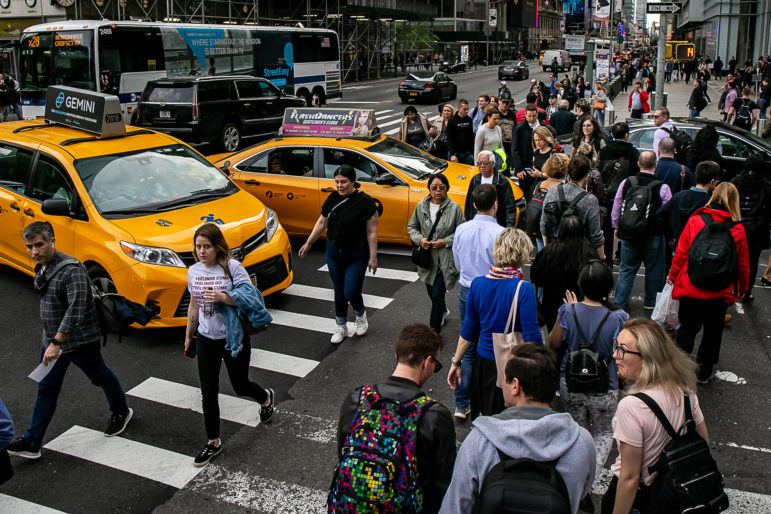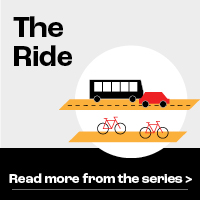More than 120 people have been killed in city traffic incidents between January and June, a new report says.

Adi Talwar
Friday evening traffic at the intersection of 42nd Street and 6th Avenues in Manhattan.Six months in and 2021 is shaping up to be one of the deadliest years for New York City traffic incidents in recent history.
According to data collected by Transportation Alternatives—a nonprofit that advocates for safer roads, bike lanes and walkways—there have already been 124 traffic deaths from Jan. 1 to June 30, more in the first half of any year under Mayor Bill de Blasio’s administration, the group says.
By the end of June, 52 motorists, 64 pedestrians and eight cyclists had been killed in traffic incidents, the data says. By May, the city had already reached 100 traffic deaths, a milestone it doesn’t typically hit until later in the year, and that month alone saw 31 fatalities, the third most deaths in a single month since de Blasio has taken office.
“More people are dying on Mayor de Blasio’s streets because he failed to quickly and aggressively scale the safety solutions of Vision Zero that he knows work, instead choosing to deliver piecemeal projects and unfulfilled promises,” said Danny Harris, executive director of Transportation Alternatives, in a press release.
Vision Zero, intended to completely reshape how the city and residents approach traffic design and safety, was first introduced in 2014. Though it had some early success, advocates say the administration’s commitment has tapered off: city traffic deaths decreased each year for the first five years of de Blasio’s tenure, but increased again in 2019 and 2020.
“Every month in 2021 we are breaking records for lives lost to traffic violence. These are our neighbors, our parents, our siblings, and our children—killed because our elected leaders failed to expand the significant early success of Vision Zero,” said Judy Kottick, a member of the advocacy group Families for Safe Streets, whose daughter Ella Bandes was killed by an MTA bus in 2013.
At a press conference Wednesday, de Blasio attributed the uptick in deaths and injuries to the COVID-19 pandemic, which caused public transit ridership to plummet and spurred people to rely more on personal vehicles. He also laid the blame on the state for not yet implementing congestion pricing, which would charge drivers a fee for entering Manhattan south of 60th Street during peak hours.
“If we’re going to disincentivize car use, particularly individual car use, and get people back to mass transit and make mass transit better so people want to be in those subways and buses, we need congestion pricing,” de Blasio said. “The state of New York and the MTA are doing essentially nothing to move it forward, and that’s got to end.”
The mayor said Vision Zero has been a success despite this year’s grim numbers.
“We’re going to keep investing in Vision Zero—more speed cameras, more enforcement, more bus lanes, more bike lanes,” he added. “We’re going to set records this year. But we need congestion pricing to get to where we really need to go.”
To see a significant reduction in traffic injuries and deaths, Transportation Alternatives says it will take a joint effort from the current mayoral administration, the next administration and the state legislature.
The group says de Blasio should follow recommendations laid out by his Surface Transportation Advisory Council, a group of advocates and business representatives appointed by the mayor to best assess traffic safety. Transportation Alternatives has a member on that council.
Some of those recommendations include expanding the number of bus lanes, promoting taxi and rideshare services over personal car ownership and limiting community boards’ say when it comes to safety plans.
For the city’s next mayor–either Democrat Eric Adams or Republican Curtis Sliwa, who will face off against one another in November’s general election–the group recommends implementing NYC 25×25, an initiative that would reserve 25 percent of the city’s street space for people, not cars.
At the state level, Transportation Alternatives would like to see the legislature pass the Crash Victim Rights & Safety Act, a package of laws that aim to curb reckless driving and promote the purchase of safer vehicles.










One thought on “Rise in Traffic Crashes Could Make 2021 Deadliest ‘Vision Zero’ Year Yet, Advocates Say”
You can improve public transportation all you want to, but the most significant change this year from my vantage point is the proliferation of illegal ATVs and dirt bikes on the city’s streets, not to mention filling residential neighborhoods with Revel scooters. My neighborhood is filled with aggravated drivers looking for parking on blocks that sometimes hold as many as two dozen scooters that are driven by people who flagrantly disobey traffic laws. I don’t know how many times this summer I was nearly hit by one going the wrong way down a one-way street. On the weekends it has become commonplace to see as many as a couple of hundred ATVs and dirt bikes swarming motorists on the Grand Central and the Jackie Robinson or Queens Boulevard and NYPD does nothing to stop it.